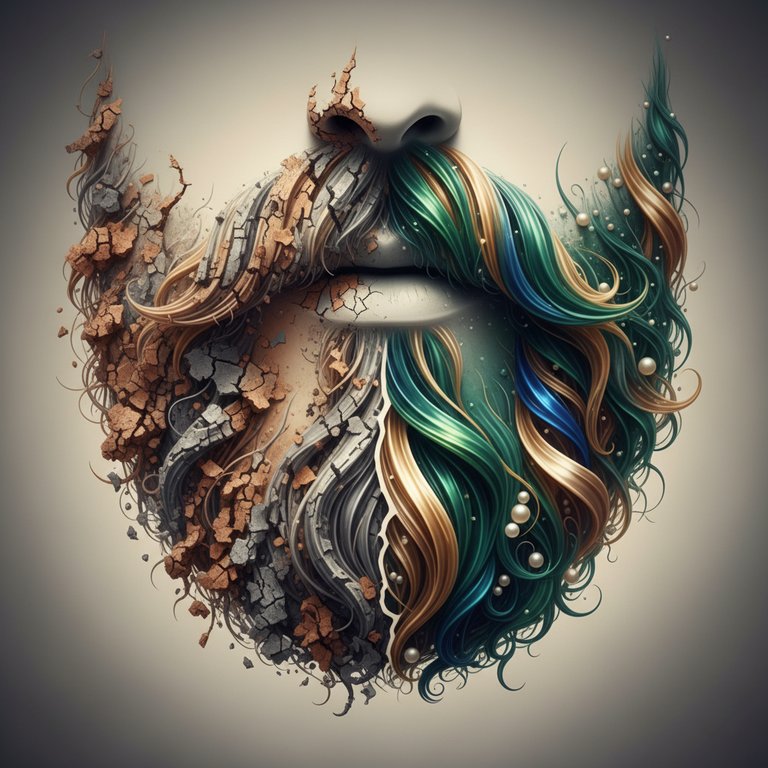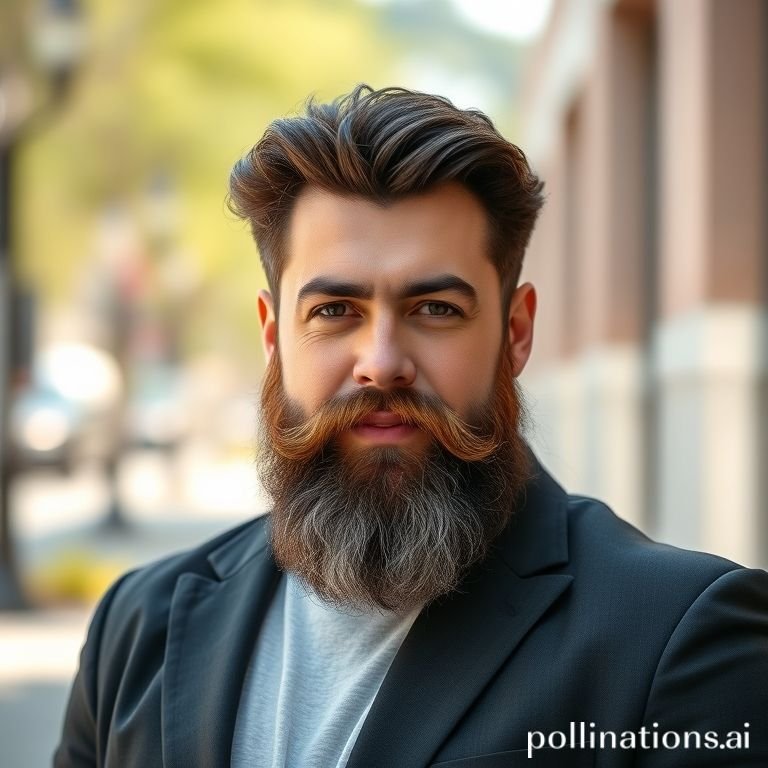Hey there, beard fam! Ever stood in the shower, staring at your trusty bottle of hair shampoo, and wondered, "Can I just use *this* on my beard?" You're not alone! It's a super common question, especially when you're just starting your beard journey or if you're looking to simplify your grooming routine. On the surface, it seems logical, right? Hair is hair, after all.
But here's the friendly truth from one beard enthusiast to another: while you *can* technically use regular shampoo on your beard, it's generally not the best idea if you want a truly magnificent, healthy, and happy beard. Think of it like this: you wouldn't use dish soap to wash your face, even though it cleans dishes really well. Different jobs call for different tools!
In this comprehensive guide, we're going to dive deep into why your head hair shampoo might be doing more harm than good to your beloved facial hair, what you should be using instead, and how to build a simple, effective beard washing routine. Get ready to unlock the secrets to a softer, healthier, and more manageable beard!
Hey there, beard fam! Before we dive in, just a friendly reminder: this post is all about grooming tips and general beard care. It's for informational purposes only and isn't a substitute for professional advice if you have specific skin concerns. We're just here to talk about making your beard look and feel awesome!
Why Your Head Hair Shampoo and Beard Are Different Beasts
At first glance, hair is hair. But the hair on your head and the hair on your face are actually quite different, and so is the skin underneath them. Understanding these fundamental differences is key to understanding why specialized beard products exist and why they're so beneficial.
Facial Hair vs. Head Hair: A Tale of Two Textures
Generally, facial hair tends to be much coarser, thicker, and often curlier than the hair on your scalp. Think about it: your head hair might be fine and straight, but your beard hair often has a mind of its own, with a more wiry texture. This difference in texture means it has different needs when it comes to cleansing and conditioning.
The Skin Beneath: A Sensitive Subject
The skin on your face is also more sensitive than the skin on your scalp. Your scalp is generally tougher and produces a different amount of natural oils (sebum) than your facial skin. Facial skin is exposed to different elements and can react more strongly to harsh chemicals.
The Role of Natural Oils (Sebum)
Both your scalp and face produce natural oils, or sebum, which are crucial for keeping your hair and skin moisturized and protected. However, the balance and composition can vary. Regular hair shampoos are often designed to strip away excess oils from the scalp, which can be beneficial for head hair that tends to get greasy quickly. But for your beard and the skin beneath, this can be a big problem.
The Harsh Truth: What Regular Shampoo Does to Your Beard
Now that we know the differences, let's get into the nitty-gritty of why reaching for that head shampoo bottle might be sabotaging your beard goals.
Stripping Natural Oils: The Moisture Thief
The primary job of most regular shampoos is to cleanse thoroughly, often using strong detergents (surfactants) to remove dirt, product buildup, and excess oil from your scalp and hair. While this might be great for your head, it's a disaster for your beard. These harsh chemicals don't discriminate; they'll strip away the vital natural oils that keep your beard soft, hydrated, and healthy. The result? A beard that feels like straw, looks dull, and can become brittle and prone to breakage.
Drying Out Your Skin: Hello, Itch and Flakes!
It's not just your beard hair that suffers. The skin underneath your beard is also highly susceptible to these drying effects. When those natural oils are stripped away, your facial skin loses its protective barrier, leading to dryness, irritation, and that dreaded beard itch and flakiness. Trust me, nobody wants a snowstorm in their beard!
Frizz and Damage: A Tangled Mess
Without adequate moisture and protection from natural oils, your beard hair becomes more vulnerable. It can lead to increased frizz, split ends, and a generally unruly appearance. A dry beard is a weak beard, making it harder to comb, style, and maintain. You'll find yourself battling tangles and a beard that just doesn't want to cooperate.
The Solution: Specially Formulated Beard Products
So, if regular shampoo is out, what's in? The answer is simple and effective: products specifically designed for beards. These aren't just marketing ploys; they're formulated with your beard's unique needs in mind.
Beard Wash: Gentle Cleansing Power
A good beard wash (often called beard shampoo) is designed to cleanse your beard without stripping away its essential natural oils. It uses milder surfactants and often includes nourishing ingredients to hydrate both your beard hair and the skin underneath. It cleanses away dirt, food particles, and environmental pollutants, leaving your beard feeling fresh and clean, but not parched.
Beard Conditioner: The Moisture Boost
Just like you condition the hair on your head, your beard needs a dedicated conditioner. Beard conditioners are formulated to be deeply moisturizing, helping to soften the coarse facial hair, detangle knots, and add a healthy shine. They replenish moisture, reduce frizz, and make your beard much more manageable and pleasant to touch. This is a game-changer for softness!
Your Go-To Beard Washing Routine
Ready to give your beard the VIP treatment it deserves? Here's a simple, step-by-step routine that will keep your beard looking and feeling its best.
Step 1: Wet Your Beard Thoroughly
Jump in the shower and let warm water run through your beard. Ensure every strand is completely saturated. Warm water helps to open up the hair cuticles and prepare your beard for cleansing.
Step 2: Apply Beard Wash
Squeeze a small amount of beard wash into your palm – a dime-sized amount is usually enough for most beards, but adjust based on length and thickness. Lather it gently between your hands, then work it through your beard, massaging it down to the skin beneath. Make sure you're cleansing both the hair and the skin.
Step 3: Rinse Thoroughly
Rinse your beard with lukewarm water until all the beard wash is completely gone. You want to ensure no residue is left behind, as this can lead to irritation or dullness.
Step 4: Condition Your Beard
After rinsing the wash, apply a small amount of beard conditioner. Work it evenly through your beard, focusing on the ends, and let it sit for a minute or two to really penetrate and moisturize. This is where the magic happens for softness!
Step 5: Rinse Again
Rinse out the conditioner with cool or lukewarm water. A cool rinse can help to close the hair cuticles, locking in moisture and adding shine.
Step 6: Pat Dry Gently
Step out of the shower and gently pat your beard dry with a clean towel. Avoid harsh rubbing, which can cause frizz and damage. You want it damp, not soaking wet, before moving to the next step.
Step 7: Apply Beard Oil and Balm
This is a crucial step! While your beard is still slightly damp, apply a few drops of beard oil. Massage it into your beard, ensuring it reaches the skin underneath to moisturize and prevent dryness. Follow up with a small amount of beard balm or butter to further condition, tame flyaways, and provide light hold for styling.
Pro Tips for a Happy, Healthy Beard
Beyond the washing routine, here are a few extra nuggets of wisdom to keep your beard in top shape:
- Don't Over-Wash: Washing your beard every single day might be too much for most. For many, 2-3 times a week is ideal, adjusting based on your lifestyle, activity level, and how oily or dry your beard tends to get. On non-wash days, a quick rinse with water and an application of beard oil can be enough.
- Mind the Water Temperature: Hot water can strip oils, so stick to lukewarm water for washing and rinsing. A cool rinse at the end can be beneficial.
- Invest in Good Tools: A quality beard comb or brush (like one made from wood or boar bristles) will help distribute natural oils and products evenly, detangle, and keep your beard looking neat without causing damage.
- Consistency is Key: Like any good habit, consistency in your beard care routine will yield the best results. Stick with it, and your beard will thank you!
- Listen to Your Beard: Pay attention to how your beard feels. If it feels dry, you might need more oil or to wash less often. If it feels greasy, you might need to adjust your product amounts or wash frequency. Your beard will tell you what it needs!
Frequently Asked Questions About Beard Care
How often should I wash my beard?
This is one of the most common questions! There's no one-size-fits-all answer, as it depends on your skin type, your environment, and your daily activities. However, for most beard wearers, washing with a dedicated beard wash 2-3 times a week is a good starting point. If you work in a dusty environment, exercise a lot, or have naturally oily skin, you might need to wash more frequently. If your beard feels dry or your skin is sensitive, you might want to wash less often. On days you don't wash, a quick rinse with water and a reapplication of beard oil can be perfect.
Why does my beard feel so dry and brittle after washing?
If your beard feels like a Brillo pad after washing, it's a huge sign that your cleansing routine is too harsh. Most likely, you're using a regular hair shampoo that's stripping away all your beard's natural, protective oils. The solution is to switch to a gentle beard-specific wash, always follow up with a beard conditioner, and crucially, apply beard oil immediately after patting your beard dry. These steps will replenish moisture and keep your beard soft and healthy.
Can I just use regular hair conditioner on my beard?
While regular hair conditioner is definitely a step up from using regular shampoo on your beard, it's still not ideal. Regular conditioners are formulated for scalp hair, which often has different needs than facial hair. Some regular conditioners can be too heavy for your beard or contain ingredients that might not be great for the more sensitive skin on your face. Beard conditioners are specifically designed to soften coarse facial hair and nourish the underlying skin without causing buildup or irritation. So, while it's better than nothing, a dedicated beard conditioner is always the best choice for optimal results.
What's the difference between beard oil and beard balm, and when should I use them?
Think of them as a dynamic duo! Beard oil is primarily for moisturizing the skin underneath your beard and conditioning the hair strands. It helps prevent dryness, itchiness, and promotes a healthy shine. It's usually lighter and absorbs quickly. Beard balm, on the other hand, is thicker and provides more styling hold, taming flyaways and shaping your beard, while also offering conditioning benefits. You should apply beard oil first, right after washing and drying your beard (when it's slightly damp), to nourish the skin and hair. Then, once the oil has absorbed a bit, follow up with beard balm to style and provide extra protection throughout the day.
How do I deal with beard itch, especially after washing?
Beard itch, especially after washing, is usually a cry for moisture! When you wash, even with a gentle beard wash, some natural oils are removed. If you don't replenish that moisture immediately, your skin can get dry and itchy. The key is to consistently use a good beard conditioner and, most importantly, apply beard oil to the skin underneath your beard right after drying. Make sure you're massaging the oil into the skin, not just coating the hair. Regular brushing with a boar bristle brush can also help exfoliate the skin and distribute oils, reducing itchiness.
Is it okay to skip beard conditioner sometimes?
While it's not the end of the world to skip beard conditioner occasionally, it's highly recommended for maintaining a soft, healthy, and manageable beard, especially if your beard is medium to long. Think of conditioner as an essential step for detangling, adding moisture, and protecting your beard from environmental stressors. If you have a very short beard or an extremely oily beard, you might find you can skip it sometimes, but for most, it's a vital part of the routine to prevent dryness, frizz, and brittleness.
What happens if I don't wash my beard at all?
If you never wash your beard, you'll likely face a few issues. Your beard will accumulate dead skin cells, food particles, environmental pollutants, and excess natural oils. This buildup can lead to an unclean, potentially smelly beard, and can irritate the skin underneath, leading to itchiness or flakiness. While over-washing is a problem, not washing at all means your beard won't be as healthy, comfortable, or presentable as it could be. Regular, gentle cleansing is important for hygiene and beard health.
Conclusion
So, can you use regular hair shampoo on your beard? Technically, yes, but it's like using a sledgehammer to crack a nut – it gets the job done, but with a lot of unnecessary collateral damage. For a truly magnificent beard that's soft, healthy, and easy to manage, investing in dedicated beard wash and conditioner is a small change that makes a huge difference.
Your beard is a statement, a commitment, and a crown of glory! Treat it with the respect it deserves by giving it the right care. You'll not only look better, but you'll feel better too, free from dryness, itchiness, and frizz. Happy grooming, my friend!
Disclaimer: This blog post provides general information and grooming tips for informational purposes only. It is not intended to provide medical advice or address specific health concerns. Always consult with a qualified professional for any personal health-related issues or medical conditions.


